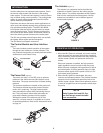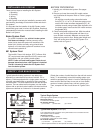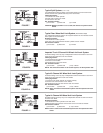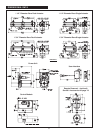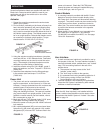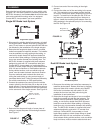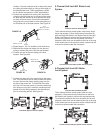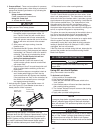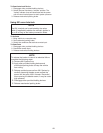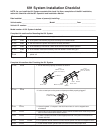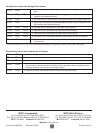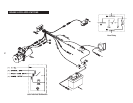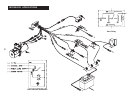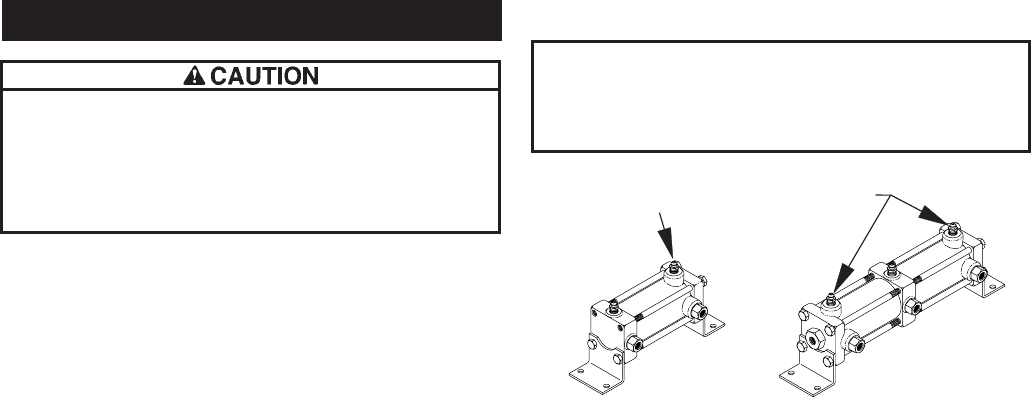
10
All electrical connections must be completed and the
power unit reservoir filled with proper fluid before bleeding.
The hydraulic brake system must be bled whenever any
line has been disconnected. Although we recommend the
use of pressure bleeding equipment when bleeding the
system, some vehicle manufacturers do not advise certain
bleeding methods. Refer to Vehicle Manufacturers bleed
-
ing recommendations. When pressure bleeding, use a
system pressure of 1.72-2.07 bar (25-30 psi).
Tips on Bleeding Brake Systems
1. Patience is often necessary. Brake fluids can be easily
aerated by being forced through tubes too fast or
agitating them. Once brake fluid has been aerated, the
best way to get the air back out is to let it sit. Several
hours or overnight may be necessary.
2. While bleeding, make every effort to move the fluid
slowly. This is especially important when applying the
brake pedal and when opening bleeder screws.
3. Avoid rapid pumping of the brake pedal as it can
cause the fluid to become aerated.
4. Always wear safety glasses and be cautious when
opening bleeder screws with any pressure applied. Air
pockets will shoot the fluid out at a rapid rate.
5. Connect a length of poly-style air line from the bleeder
screw into a container to recapture the fluid during the
bleeding process.
6. In some cases, gravity bleeding is the best form of
bleeding.
7. Start bleeding process at the actuators and work
toward the foundation brakes.
8. Even when the brake system seems to be well bled, it
may still contain small amounts of air. We recommend
re-bleeding the brake system after the vehicle has
been parked overnight.
Bleeding Procedures
1. Disconnect the vehicle horn and other warning
devices.
2. Be sure the 691 Power Unit reservoir remains filled
with the proper fluid during entire bleeding process.
Check the CAUTION label on the 691 Power Unit
reservoir for proper fluid type.
3. Make sure the vehicle master cylinder reservoir is full
of fluid specified by the vehicle manufacturer.
4. Gravity Bleed - After the initial installation, DO NOT
apply the brake pedal. Remove the cap from the
master cylinder reservoir. One at a time, open each
bleeder screw in the vehicle brake system beginning
with bleeder screws on the actuators and moving
outward to the foundation brakes. NOTE: In some
situations, to save time, all bleeder screws may be
opened simultaneously. Do not deplete reservoir
fluid level. When a steady stream of fluid is present,
close the bleeder and proceed to the next. If gravity
flow is not obtained within 5 minutes, proceed to next
step. (Also check for blocked or crimped lines, or
loops in tubing where air may be trapped).
5. Manual Bleed - Manually bleed the brakes, depress-
ing and releasing brake pedal slowly and to disperse
fluid through the brake system without agitating it. Do
not depress pedal when bleeder screw is closed. Do
not release pedal when bleeder screw is open. Bleed
691 Actuators first. After actuators are bled, continue
by bleeding foundation brakes.
A. Open bleeder screw, then slowly apply the pedal
to the limit of its stroke.
B. Close the bleeder and slowly release the pedal.
C. Repeat this process multiple times at each bleed
point without pumping the pedal in-between.
BLEEDING
Vehicle Brake System: Always use clean fluid con
-
forming to vehicle manufacturer’s recommendations.
691 Power Unit: Check the CAUTION label on the
691 Power Unit reservoir for proper fluid type. Refer
to Figure 13.
Brake System
Bleed Point
Brake System
Bleed Point
FIGURE 22
NOTE
To assure successful brake system bleeding, complete
all bleeding procedure steps in the order that they are
listed.



